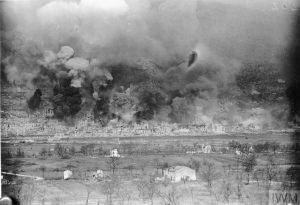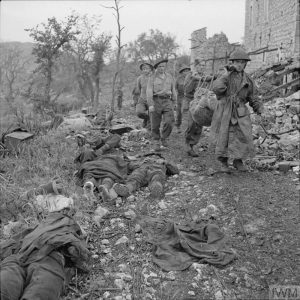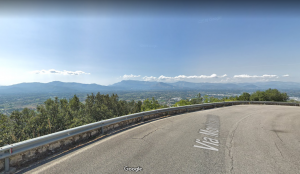Battle(s) for Monte Cassino
The 11th of May marks the 75th anniversary of the start of the final Battle for Monte Cassino. Monte (Mount) Cassino and the town of Cassino sit in central Italy, South East of Rome. Atop the mountain was situated a large Monastery overlooking the town to the South and the Liri River and Valley to the West. Between December 1943 and May 1944, the Allies had been stuck at Monte Cassino. Three significant battles had already taken place between January and April and had all fallen short, costing thousands of lives in the process.

Above: Modern map illustrating the relationship between Cassino, the Liri Valley, and Rome. Credit: Google Earth
The fighting around Monte Cassino was some of the bloodiest of the Second World War and bears re-telling in part. Soldiers from Britain and the Commonwealth (including New Zealand, Australia, Canada and India), Poland, Free France, Libya and Tunisia, the Italian Resistance, and the United States were thrown against this mountain and tens of thousands perished around it. The entire campaign in Italy would result in more than 300,000 casualties, around one-sixth of which would occur around Monte Cassino.
The importance of Monte Cassino to the Germans cannot be understated and it’s worth exploring why so many Allied and Axis soldiers met their end here. The Liri Valley, sometimes called the Latin Valley is a large area of open flat ground, running South East from Rome down towards Naples, flanked by mountainous terrain. An important arterial road (Route 6) ran through the valley to Rome.
Above: This modern-day view shows the advantage provided by the mountain itself. Credit: Google Maps
In front of Route 6 and the gateway to the valley a string of defensive positions called the ‘Gustav Line’ ran along the Gari and Rapido Rivers and into the town of Cassino. The stronghold monastery on the mount above watched over this line and the valley itself. German positions in the monastery (up and behind the viewpoint shown in the image above) meant that even if the Allies could break through the Gustav Line they would be caught in the open terrain of the valley by forces atop the monastery. Along both sides of the valley ran long mountain ranges, virtually impassable to vehicles, and so Route 6 and the area around it was the only realistic way to get to Rome.
One Final Push
The fourth battle (Operation ‘Diadem’), destined to be the final, was set for May with a new comprehensive plan and expectations of better conditions. 75 years ago, on the 11th May, the 2nd Battalion of the DCLI were waiting close to the River Gari-Rapido. Along with the rest of 10th Brigade (2nd Battalion, Bedfordshire and Hertfordshire Regiment and 1st/6th Battalion, Surrey Regiment) their job was to cross the river at their designated point and form bridgeheads on the other side. Once across they would assault the Gustav Line and push the Germans back off their defensive lines, covering the construction of bridges for heavy support to cross. Assaults by other Brigades up and down the line would commence at the same time.
Meanwhile, French and Polish forces in the mountains above would capture the fortress monastery itself. Whilst these units crept forward into positions to assault the monastery, those in the valley below prepared for the crossings by covertly moving equipment and ammunition to the banks of the river. At 11pm on the 11th May over a thousand cannons began slamming the mountainside and the Gustav Line with a terrible barrage. 45 minutes later elements of 2nd Battalion DCLI supported the main assault in their section, and soon after made secondary crossings to expand the bridgehead. The task would test the DCLI to their absolute limits.

Above: Photo taken during bombing raid of 15 March 1944, which began the third battle of Monte Cassino. Just after this, 600 pieces of artillery opened their barrage. A little under two months later, a barrage from 1,600 pieces would mark the start of the final battle. © IWM (EA 17892)
As in the many months of fighting before this day, the Germans issued their swift and brutal response. The assault again fell short.
Parts of 2nd Battalion made the other side of the river by 4am, but only just. The heavy response of the Germans made further crossings untenable in the coming daylight, and the DCLI were cut off. Morning mist covered the crossing of more DCLI infantry, but the window was short-lived. The Battalion was pinned down on the enemy’s side of the river with little cover and support. If a counter-attack had taken place, they would have been overwhelmed entirely, but fortunately no attack came. For nearly two days they sat entrenched as much as possible on the banks of the river.
Through the night of the 12th, Royal Engineers tirelessly constructed their temporary bridges under heavy barrage. The river and banks were covered with the bodies of Sappers and soldiers alike, but the bridge was completed.
At dawn, tanks of the 17th/21st Lancers crossed the river and in the afternoon the rest of 2nd Battalion crossed with the support of yet more tanks. Before they could relieve the rest of their battalion they were to capture Point 63, a strong-point overlooking the bridgehead. They did so and soon tanks were dispatched to relieve those DCLI soldiers who had been stuck on the banks of the river. They assaulted the Germans who had pinned them down and finally moved to Point 63 to meet the rest of the battalion.

Above: Photo of the remains of the Monastery just after it was captured by Polish soldiers on 18 May 1944. © IWM (NA 15141)
The monastery in the mountains above was captured soon afterwards on the 18th May, but the DCLI were already on their way to the back for some much-deserved rest and recuperation. The Battalion Commander, Lieutenant-Colonel Musson, received the Distinguished Service Order in recognition of his work during the battle, which included riding atop the lead Sherman tank crossing the Rapido with his battalion. The DCLI’s experience at Monte Cassino was characteristic of the fighting that had gone on for months in the area without success and costing thousands and thousands of lives.

Above: Polish Soldiers recovering dead comrades after the last battle, May 1944. © IWM (NA 15138)
Redemption for the losses at the stall at Cassino soon came; once through the gateway and on Route 6, it was the Allies who finally had the upper hand. Rome fell on the 4th June. Within two months they had reached Florence and were on the door-step of Northern Italy. The terrain of Italy was gruelling for the DCLI, and Cassino was not the last arduous river crossing they would find themselves involved in. It was tough fighting, but the victory at Monte Cassino vitally put the Germans and remaining Italians on the back foot.
D-Day Dodgers?
When Operation Overlord and the invasion of Normandy around D-Day took place a month later, the contribution and efforts of soldiers in Italy would be side-lined. After all their efforts at places like Cassino, soldiers in Italy received little commendation. A comment purportedly first made by MP Lady Astor expressed that the soldiers in the Italian Campaign were ‘Dodging D-Day’. Those in Italy were incensed by this idea but taking it in their stride a song titled ‘The D-Day Dodgers’ gained widespread popularity.

ABOVE: ‘THE D-DAY DODGERS BANJO’ HELD IN THE MUSEUM COLLECTION. FEATURES THE CAP BADGE EMBLEM OF THE DCLI AS WELL AS THE INSIGNIA OF THE 4TH INFANTRY DIVISION (RED CIRCLE WITH A QUARTER OR ‘FOURTH’ CUT AWAY). WRITTEN ALL ACROSS THE BODY, NECK AND HEADSTOCK ARE THE NAMES OF PLACES THROUGH WHICH THE SOLDIERS WHO HAD THE BANJO PASSED, FOR EXAMPLE SEE THE LEFT PART OF THE FACE (NEXT TO THE DCLI INSIGNIA) WHICH READS ‘GUSTAV LINE’ WHERE THE BATTLE OF MONTE CASSINO TOOK PLACE!
It was sung to the tune of Lili Marlene which itself had been a popular ditty of both Allied and Axis forces fighting in North Africa. Its lyrics formed an ironic protest to the idea that Allied forces in Italy were lazy slackers avoiding the hard fight in Normandy. Though tongue-in-cheek it would likely have masked a deeper resentment given that those singing the comedic lament would have lost a great many friends and allies in the waters and hills around Cassino.
So, what do you think? Were these soldiers Dodging D-Day in the Italian Countryside? Or was their experience just as tough (or perhaps tougher) than those in the fields of France and Belgium? You can learn more about the DCLI in the Second World War in our re-interpreted section in the galleries. You can also learn about the role of songs and music in the military in our new exhibition ‘Music, Military and Morale’.
Written By Chris Berriman Collections and Digital Intern (2018-19) at Bodmin Keep



